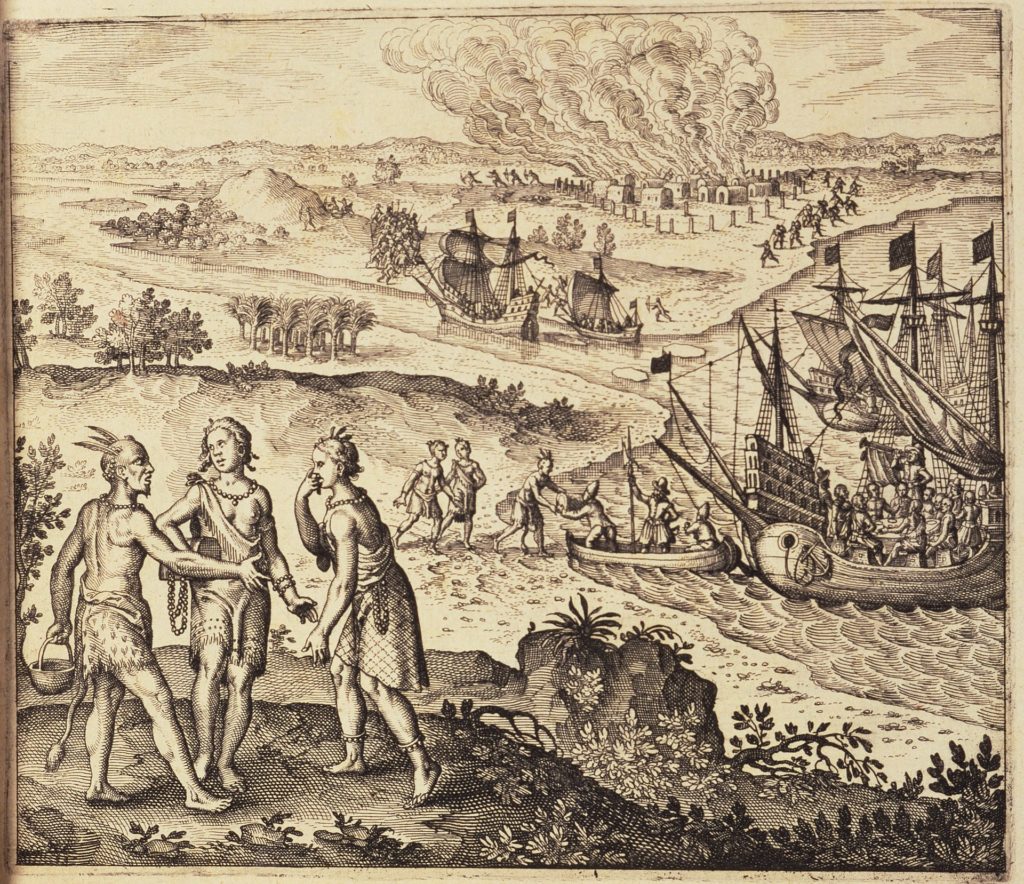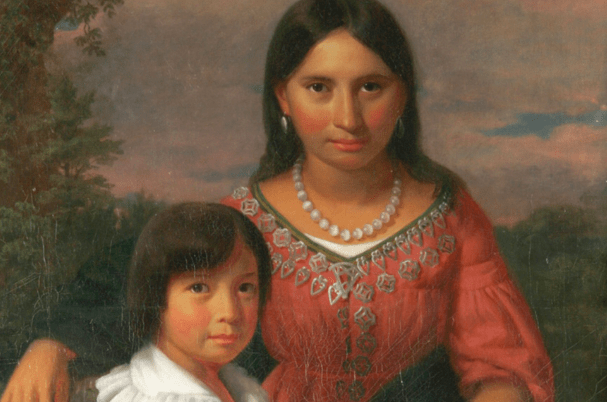In 2014, the Pamunkey Indian Museum and Culture Center, the Patawomeck Heritage Foundation, Historic Jamestowne, the Colonial Williamsburg Foundation, and Preservation Virginia, among others, celebrated the 400th anniversary of the Pocahontas-Rolfe marriage.
This unusual marriage that took place in 1614 between the daughter of a Powhatan chieftain and an English colonist significantly impacted the United States’ future, primarily through their son — Thomas Rolfe.

Thomas Rolfe’s Native American Lineage: The Story of Pocahontas
Many of us are familiar with the Disney version of Pocahontas. History, however, tells a different story.
The Native American version of what happened to Pocahontas stands in stark contrast against the romanticization of Pocahontas’ tale through time. The following overview scratches the surface of what in-depth study of the historical record, literature and oral histories from self-identified descendants of Pocahontas and Virginian natives have revealed about Pocahontas’ life.
Born “Matoaka,” Pocahontas was the beloved daughter of Wahunsenaca, the Powhatan tribe’s chief. She was first married at 14 to Kocoum, a young warrior from the Potowomac tribe. Together, they had a child, “little Kocoum.”
In 1613, Pocahontas was captured by the English settlers and taken to Jamestown, where she was held captive.
In the oral histories of Mattaponi, one of the two known Virginia tribes, Pocahontas is believed to have been raped by one or more Englishmen while in captivity.
She later converted to Christianity, took on the name Rebecca, married Englishman John Rolfe in 1614, and bore him a son, Thomas Rolfe.
However, the Mattaponi believe Thomas Rolfe was born before the marriage, allegedly from the rape, since there is no official record of Thomas’ date of birth, which is against what official Christian customs at the time dictated.
Pocahontas and her new husband eventually traveled to England, where she was presented to the king and queen. Pocahontas was a celebrity for a while, although she never got the opportunity to meet her tribe again.
Pocahontas later became ill and died in England at the age of 21.
Despite several sources portraying Pocahontas’ re-marriage to John Rolfe as a tale of romance and love, Native American records claim the opposite.
A careful reading of their records details incidences of kidnapping, forced assimilation, rape, and murder, as well as the colonists’ use of natives as an exotic show to keep the colonists financially supported.
Pocahontas was also suspected of being poisoned shortly after expressing a wish to return home.
Thomas Rolfe’s Birth and Early Years
Records suggest that Pocahontas and John Rolfe’s union resulted in only one child, Thomas Rolfe.
Several sources indicate Thomas was born in Virginia and named Governor Sir Thomas Dale. The Governor is said to have traveled with the Rolfe family to England around 1616; he was also Pocahontas’ keeper during her captivity.
Thomas was just one year old when the voyage began, leaving him vulnerable to illnesses. He and Pocahontas contracted a fever in the spring of 1617, but they survived.
However, before they could set sail to return to Virginia, Pocahontas passed away unexpectedly. Her death was allegedly caused by either tuberculosis or pneumonia, although there are speculations of her being poisoned.

Thomas’ father, John Rolfe, left his son in the care of his brother, Henry, since he was thought too unwell to travel. John sailed back to Virginia and died without seeing his son again.
In October 1622, Henry petitioned the Virginia Council, claiming possession of a portion of John Rolfe’s estate after his brother passed away.
At this point, Thomas was around 20 years old. Rumors had also begun circulating in 1618 that when Thomas reached adulthood, he would inherit a sizable portion of Powhatan land.
It was claimed that Opechanano, chief of the Powhatan Confederacy in modern-day Virginia, and the Natives had handed their country to Rolfe’s child and would keep it from all others until he came of age.
Back to Virginia, His Mother’s Homeland
Because there is no documentation chronicling Thomas Rolfe’s travels or activities until 1641, it is assumed that he arrived in Virginia in the mid-1630s.
After landing in Virginia, Thomas Rolfe grappled with the two sides of his ancestry — being a plantation owner and part of his mother’s tribe.
Around the 1640s, Thomas reportedly received sizable property from his father in Virginia that was situated next to the James River. Later in June 1654, he acquired more land in the vicinity of Jamestown, which was allegedly given to him by an “Indian King” as a token of appreciation for safeguarding his legacy.
While his status as a land heir may have been advantageous to Rolfe, it was a source of concern regarding establishing his identity.
Because he was the child of a Native American woman and a European man, it was said that Rolfe’s life was tainted by controversy. Because even though his mother was Native American, his father’s reputation as a land grabber for his tobacco plantation did not sit well with the Virginia natives.
Nonetheless, Thomas reportedly wanted to connect with his relatives from his Native American side of the family despite cultural rejection and laws forbidding such interaction.
In 1641, he allegedly asked the Governor to allow him to meet his uncle Opecanaugh and was given permission. There is, however, no account of this meeting.
Despite these initiatives, Thomas lived a more significant portion of his life as an Englishman. He reinforced this by rising to the English military lieutenant rank.
Marriage and Family Life
In September 1632, Thomas married Elizabeth Washington at St James’s Church in Clerkenwell. A year later, in 1633, they had a daughter named Anne, but soon after, Elizabeth passed away.
Later, Thomas married Jane Poythress, Captain Francis Poythress’s daughter, and had another daughter named Jane. To pursue inheritance, Thomas placed Jane in the care of Anthony Rolfe, his cousin.
Impact of His Daughters’ Marriages
Anne Rolfe
Anne Rolfe married Peter Elwin (also spelled Elwyn), and many Anglo-Americans claim lineage from Pocahontas and John Rolfe through this alliance.
This weak argument is the cause of great exasperation to many Native Americans today because those who make such assertions use it as an excuse to dismiss “land back” claims and refuse to take accountability for the horrors committed by early European immigrants against the indigenous people.
However, many white Americans believe they are descended from Pocahontas through DNA testing and other means of tracing their lineages.
Jane Rolfe
In 1675, Jane, Thomas Rolfe’s second daughter, married Colonel Robert Bolling, and their union brought one child, John, born on January 26, 1967.
Indigenous Americans would feel the impact of John’s birth as Thomas Rolfe’s grandson for many years to come.
In a deed dated 1698, John inherited Fort James from his mother, Jane, and conveyed the territory to William Brown. Several historians used this deed as a benchmark for predicting Thomas Rolfe’s death. Rolfe was described in the said deed as “deceased.”
Significance of Thomas Rolfe’s Life
Thomas Rolfe’s birth was said to have fostered peace between the Powhatans and the European colonists because he was both European and Native American.
Captain Samuel Argall, who captured Pocahontas, noted in a letter preserved in the Virginia Company Records that while the Powhatan chief mourned the loss of his daughter, he was glad that her son was still alive.
Rolfe’s birth might be seen as a catalyst for the unification of European and American cultures, but his adulthood was leveraged solely for the benefit of white settlers.
This was evident when, following the Native Americans’ attack on the colony in 1644, four forts were reportedly erected to guard the frontier: Fort Henry, Fort Charles, Fort Royal, and Fort James.
On October 5, 1646, Rolfe was named lieutenant and given command of Fort James, tasked with six soldiers to fight his own people, the Powhatans.
Following the war, Rolfe was reputedly given the difficult task of building a fort on the Chickahominy River at Moysenac, now New Kent County.
His Final Days
Apart from the major life events described here, the bulk of Thomas Rolfe’s life remains unknown.
The only final event of Thomas Rolfe’s life that has been documented in the archives took place on September 16, 1658, in the form of a land deal. Various records indicate that Rolfe died in 1680, but contemporary sources assert that the actual day and year of his death are unclear.
Furthermore, despite some documents suggesting that he died peacefully in his favorite James City property in Virginia, the reason for his death is subject to debate due to the lack of verifiable records.
Regardless, Rolfe lived and died a wealthy man. On the other hand, his mother’s people would suffer evictions from the land where their ancestors had lived for many generations before European immigrants arrived.
Thomas Rolfe: A Life That Could’ve Been
Many historians have speculated on what could have been if Thomas Rolfe’s childhood had been spent between both cultures.
Rolfe could have been able to experience the best of both worlds if he had been adequately exposed to the customs and lifestyles of both England and Virginia. He would also have been a proud Virginian native while valuing the opportunities that England provided.
His existence, then, would have been a historical presence during the colonial era, serving as an intermediary between the two clashing civilizations.
If that had happened, his descendants today would have had more substantial claims to make in the face of modern America’s increasingly divisive cultures and politics.
They would become effective allies — not just for Native Americans in their fight against corporate encroachment on indigenous territories but also as advocates for the descendants of early European immigrants.

